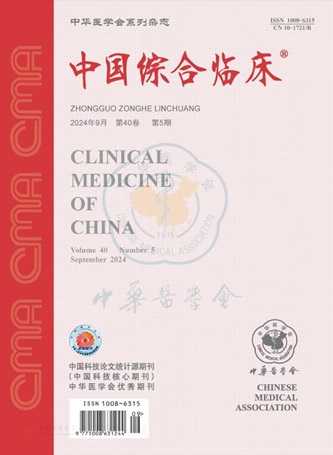Study on the relationship between Plasma Pro amino terminal brain natriuretic peptide, left ventricular mass index and the prognosis in elderly heart failure patients with preserved ejection fraction
引用次数: 0
Abstract
Objective To investigate the clinical value of plasma N-terminal pro-brain natriuretic peptide(NT-proBNP)and Left ventricular mass index(LVMI )in evaluating the prognosis of elderly heart failure patients with preserved ejection fraction (HFpEF). Methods From January 2018 to December 2018, 170 patients with heart failure (age≥65years old) in the Third Affiliated Hospital of Anhui Medical University were selected as the subjects of prospective study.According to the left ventricular ejection fraction (LVEF), the patients were divided into two groups: the heart failure with preserved ejection fraction (HFpEF) group (100 cases), the heart failure with reduced ejection fraction (HFrEF) group (70 cases), and the healthy subjects (58 cases) as the control group.Left atrial diameter (LAD), interventricular septum thickness (IVST), left ventricular posterior wall thickness (LVPWT), left ventricular end diastolic diameter (LVEDD), LVEF, left ventricular mass index (LVMI) and plasma NT-proBNP concentrations were compared among the three groups.The study group was followed up for 6 months after standardized treatment to observe the occurrence of major cardiovascular adverse events (MACE). Multiple logistic regression was used to analyze the correlation between the above indexes and the occurrence of mace.ROC curve was used to analyze the predictive value of NT proBNP and LVMI. Results There were significant differences in LAD, IVSTt, LVPWT, LVEDD, LVEF and LVMI among each group (F value was 110.878, 75.838, 74.044, 137.985, 495.267 and 122.810, respectively, all P<0.001 ). The LAD, IVST, LVPWT, LVEDD, and LVMI in the HFpEF group((40.81 ±4.46) mm, (9.39±1.15) mm, (9.68±1.11) mm, (55.54±3.67) mm, (125.45±19.17) g/m2) were higher than those in the control group ((32.9±3.20) mm, (7.62±0.64) mm, (7.81±0.58) mm, (47.05±3.13) mm, (77.72±11.79) g/m2), and the LVEF was lower than that of the control group ((59.63±5.23)% vs.(67.7±4.35)%) with statistical significance (all P<0.05). IVST, LVPWT, LVEF in HFpEF group( (9.39±1.15) mm, (9.68±1.11) mm, (9.63±5.23)%) were higher than those in HFrEF group ((7.59±1.28) mm, (8.01±1.39) mm, (36.9±7.63 )%) ; and the LAD, LVEDD in HFpEF group ((40.81±4.46) mm, (55.54±3.67) mm) were lower than those in HFrEF group ((45.51±6.1) mm, (64.77±9.55) mm), and the differences were statistically significant (all P<0.05). The plasma NT-proBNP concentration was the lowest in the control group, followed by the HFpEF group and the highest in the HFrEF group(56.0 (30.0, 78.56), 2 624.5 (1 190.5, 5 558.5), 8 528.5 (2 651.0, 21 582.75), F=81.355, P<0.01). Multivariant Logistic regression analysis showed that NT-proBNP and LVMI were independent risk factors for occurrence of MACE in patients with HFpEF(OR=4.796, 95%CI: 2.348-5.127, P=0.035; OR=1.957, 95%CI: 1.810-3.327, P=0.016). ROC curve analysis showed that the area under the curve of cardiovascular adverse events predicted by NT-proBNP and LVMI for 6 months was 0.888(95%CI: 0.825-0.950, P<0.001) and 0.713(95%CI: 0.613-0.812, P=0.013). Conclusion NT-proBNP and LVMI have important value for prognosis evaluation in elderly patients with HFpEF. Key words: Heart failure; Heart failure with preserved ejection fraction; N-terminal pro-brain natriuretic peptide; Left ventricular mass index; Prognosis保留射血分数的老年心力衰竭患者血浆氨基末端前脑利钠肽、左心室质量指数与预后关系的研究
目的探讨血浆N-末端脑钠素原(NT-proBNP)和左心室质量指数(LVMI)在评价射血分数保留的老年心力衰竭患者预后中的临床价值。方法选择安徽医科大学附属第三医院2018年1月至2018年12月收治的170例年龄≥65岁的心力衰竭患者作为前瞻性研究对象。根据左心室射血分数(LVEF),将患者分为两组:保留射血分数心力衰竭(HFpEF)组(100例)、降低射血分数心衰组(HFrEF)(70例)和健康受试者(58例)作为对照组。比较三组患者的左心房直径(LAD)、室间隔厚度(IVST)、左心室后壁厚度(LVPWT)、左室舒张末期直径(LVEDD)、LVEF、左心室质量指数(LVMI)和血浆NT-proBNP浓度。研究组在标准化治疗后随访6个月,观察主要心血管不良事件(MACE)的发生情况。采用多元逻辑回归分析上述指标与狼牙病发生的相关性。ROC曲线用于分析NT-proBNP和LVMI的预测价值。结果各组LAD、IVSTt、LVPWT、LVEDD、LVEF和LVMI均有显著性差异(F值分别为110.878、75.838、74.044、137.985、495.267和122.810,P均<0.001)。HFpEF组的LAD、IVST、LVPWT、LVEDD和LVMI((40.81±4.46)mm、(9.39±1.15)mm、,LVEF低于对照组(59.63±5.23)%与(67.7±4.35)%,差异有统计学意义(均P<0.05),HFpEF组IVST、LVPWT、LVEF分别为(9.39±1.15)mm、(9.68±1.11)mm和(9.63±5.23;HFpEF组的LAD、LVEDD((40.81±4.46)mm,(55.54±3.67)mm)均低于HFrEF组的(45.51±6.1)mm、(64.77±9.55)mm,差异有统计学意义(均P<0.05),8 528.5(2 651.0,21 582.75),F=81.355,多元Logistic回归分析显示,NT-proBNP和LVMI是HFpEF患者发生MACE的独立危险因素(OR=4.796,95%CI:2.348-5.127,P=0.035;OR=1.957,95%CI:1.810-3.327,P=0.016)结论NT-proBNP和LVMI对老年HFpEF患者的预后评估具有重要价值。关键词:心力衰竭;射血分数保留的心力衰竭;N-末端脑钠肽原;左心室质量指数;预后
本文章由计算机程序翻译,如有差异,请以英文原文为准。
求助全文
约1分钟内获得全文
求助全文
来源期刊
CiteScore
0.10
自引率
0.00%
发文量
16855
期刊介绍:
Clinical Medicine of China is an academic journal organized by the Chinese Medical Association (CMA), which mainly publishes original research papers, reviews and commentaries in the field.
Clinical Medicine of China is a source journal of Peking University (2000 and 2004 editions), a core journal of Chinese science and technology, an academic journal of RCCSE China Core (Extended Edition), and has been published in Chemical Abstracts of the United States (CA), Abstracts Journal of Russia (AJ), Chinese Core Journals (Selection) Database, Chinese Science and Technology Materials Directory, Wanfang Database, China Academic Journal Database, JST Japan Science and Technology Agency Database (Japanese) (2018) and other databases.

 求助内容:
求助内容: 应助结果提醒方式:
应助结果提醒方式:


